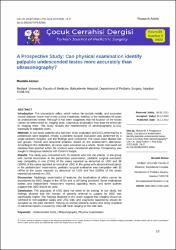| dc.contributor.author | Akman, Mustafa | |
| dc.date.accessioned | 2023-09-12T08:22:05Z | |
| dc.date.available | 2023-09-12T08:22:05Z | |
| dc.date.issued | 2022 | en_US |
| dc.identifier.citation | Akman, M. (2022). A Prospective Study: Can physical examination identify palpable undescended testes more accurately than ultrasonography? Turkish Journal of Pediatric Surgery, 36(3), 19-27. https://dx.doi.org/10.29228/JTAPS.62854 | en_US |
| dc.identifier.issn | 1305-5194 | |
| dc.identifier.issn | 2667-7024 | |
| dc.identifier.uri | https://dx.doi.org/10.29228/JTAPS.62854 | |
| dc.identifier.uri | https://hdl.handle.net/20.500.12511/11412 | |
| dc.description.abstract | Introduction: The cremasteric reflex, which makes the testicle mobile, and excessive scrotal adipose tissue may mimic scrotal emptiness, leading to the evaluation of cases as undescended testes. Although it has been suggested that the location of the testes cannot be determined by imaging tests, suspicious localization may lead the physician to imaging tests. This study reveals the needlessness of ultrasonography (USG), especially in palpable cases. Methods: In our study, patients who had their initial evaluation and USG performed by a pediatrician were targeted. Finally, a pediatric surgical evaluation was performed by a single pediatric surgeon, and the findings were compared. The cases were divided into two groups, normal and abnormal testicles, based on the pediatrician's distinction. According to this distinction, all cases were evaluated as a whole. Testes that could not maintain their position within the scrotum were considered abnormal. Consistency was sought in intergroup relations with Cohen's Kappa. Results: The study was conducted with 75 patients who met the criteria. In the group with normal localization in the pediatrician examination, pediatric surgical evaluation was compatible in one (2.6%) of the cases reported as abnormal on USG and 38 (100%) of the cases reported as normal on USG. In the group with abnormal localization in the pediatricians’ examination, pediatric surgical evaluation was compatible with 32 (40%) of the cases reported as abnormal on USG and four (100%) of the cases reported as normal on USG. Discussion: Radiologic examination of testicles, the localization of which cannot be ascertained by USG, began in the 1970s and is still being practiced. Some institutional bodies and independent researchers express opposing views, and some authors suggest that USG should be used. Conclusion: The popularity of USG does not seem to be ending. In our study, the findings showed that the number of patients referred to surgery by USG was significantly higher. The findings obtained in this study suggest that imaging should be confined to non-palpable cases and USG only, and diagnostic laparotomy should be accepted as the gold standard. Relying on normal pediatric exams and being skeptical of abnormal reports revealed by USG will mean staying on the safe side. | en_US |
| dc.language.iso | eng | en_US |
| dc.publisher | Logos Medical Publishing | en_US |
| dc.rights | info:eu-repo/semantics/openAccess | en_US |
| dc.subject | Undescended Testis | en_US |
| dc.subject | Ultrasonography | en_US |
| dc.subject | Physical Examination | en_US |
| dc.title | A Prospective Study: Can physical examination identify palpable undescended testes more accurately than ultrasonography? | en_US |
| dc.type | article | en_US |
| dc.relation.ispartof | Turkish Journal of Pediatric Surgery | en_US |
| dc.department | İstanbul Medipol Üniversitesi, Tıp Fakültesi, Cerrahi Tıp Bilimleri Bölümü, Çocuk Cerrahisi Ana Bilim Dalı | en_US |
| dc.authorid | 0000-0002-6789-4585 | en_US |
| dc.identifier.volume | 36 | en_US |
| dc.identifier.issue | 3 | en_US |
| dc.identifier.startpage | 19 | en_US |
| dc.identifier.endpage | 27 | en_US |
| dc.relation.publicationcategory | Makale - Uluslararası Hakemli Dergi - Kurum Öğretim Elemanı | en_US |
| dc.identifier.doi | 10.29228/JTAPS.62854 | en_US |
| dc.institutionauthor | Akman, Mustafa | |
| dc.identifier.scopus | 2-s2.0-85169426174 | en_US |
| dc.identifier.trdizinid | 1187716 | en_US |
| dc.identifier.scopusquality | Q4 | en_US |


















